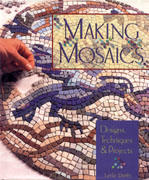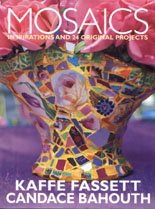Here are a few mosaic making tips in "question and answer" form. For more information about how I make my mosaics, look in the galleries and, especially, in the projects. Good sources for methods and materials include the Mosaic Matters site and the mosaics group at Yahoo (search the archives). See the links page for details of both of these.
Tips for making mosaics
Can you recommend any good books on the subject?
There are lots of books out there, but I particularly recommend "Making Mosaics" by Leslie Dierks. It was the first mosaic book I had, a few years ago, and it got me going!
I'm a big fan too of "Creating with Concrete" by Sherri Warner Hunter as an excellent source about cement-based materials: The book is currently being reissued in a new edition called "Making Concrete Garden Ornaments"
Also very good and full of pique assiette projects is "Mosaics" by Kaffee Fassett and Candace Bahouth.
Nobody should ever have to be without a copy of "Fantasy Worlds" by Deidi von Schaewen and John Maizels. It has glorious pictures of visionary environments built by outsider artists in Europe, the USA and elsewhere in the world. It's surely one of the most worthwhile books ever produced by the human race. I adore this book!




How do you keep the final level of a piece flat when using different types of china, etc.? I attempted a small serving tray, but I can't carry anything on it - everything wobbles.
Mostly, you can't keep it level, I'm afraid. For my coffee table I put in some plate bases for standing things on. Generally if you use a lot of small pieces of roughly the same thickness, and nothing too curved, the plates and mugs will sit reasonable flat. The alternative could be to use pieces of tile all of the same thickness.
I want to do a large floor mosaic under a rustic arbour and seat . I've collected a few tiles, but can I use shards on the ground?
I can see 3 ways of going about it. One would be to lay a concrete area and press the shards into it while it's still wet. Alternatively you could cast your own paving stones, using the "indirect method". The principle is he same as I used to make my garden owl, but using a square wooden frame and a flat surface. The easiest solution would be to use standard ready-made paving stones and mosaic onto them, using cement mortar (3 parts cement to 1 part sand) as an adhesive (a little blob under each piece) and then grout when dry with cement mortar (which could be coloured if you wish).
Some tiles and crockery shards can stand up to being underfoot out of doors, but it might depend on the amount of frost where you live and the quality of the materials - softer, cheaper crockery or tiles may chip underfoot if there's a lot of wear, or be prone to frost damage in winter.
I'm terrible at drawing - stick people are my specialty. I've heard there are computer programs that can help with design and layout of mosaics.
I tend to use tracings of images, to make up for my lack of drawing skill. You can scale up the size with an enlarging photocopier, or using the scaling technique described here (where you'll also find notes on software).

I have recently started mosaics and I am having a difficult time finding interesting china pieces. Any suggestions?
Try jumble sales, car boot sales, charity/thrift shops. Ask all your friends and family to keep things they break. You could even ask at crockery shops if they have any breakages!! I used to do some voluntary work for a charity shop and I was allowed to keep crockery which was donated broken or was generally unsaleable.
I've been trying to get up enough courage to touch and inhale mastic bond. This has been a major deterent for me in beginning pique assiette. I was interested to read your reference to plain household glue, in relation to the house number plate project, which was to go outside.
The glue I use for most of my projects is PVA glue. I think it's called white craft glue in the USA. There is a water-soluble version, which I avoid (this is what they prefer to use in schools because it washes out of clothes). Instead I get mine from a builders' merchants - but craft shops and DIY stores also sell the stuff. For the house number I used a waterproof PVA (sold for exterior woodwork uses) on weather-proof board. You might want to seek local advice for outdoor materials, depending on your climate
I think I understand the indirect method of gluing the tiles to the surface and then grouting, but how do you make mosiacs like vases and other irregular objects. I've heard that you put the grout down first and press them in - is that right?
Here's a quick lowdown on the "methods": Gluing the tiles to the surface and then grouting is actually the direct method. It's the one I use most, and is described in the house number plate project.
The indirect method involves sticking the pieces face down on a surface (e.g. paper, a flat sheet or a mould) using a water-soluble glue. When the glue has dried you fill in from the back with grout or cement. When that's set you soak off the glue on the front. Then you grout from the front (as with the direct method). This method is especially good for when you need a flat surface e.g. a stepping stone. I used a variation on this method for my garden owl and the hemispherical plant pots.
To mosaic 3D objects, such as the lamp bases and the planter (project 7) I use the direct method. I would tend to use a ready mixed tile adhesive or a cement mix (rather than PVA/white glue), because it's very sticky and grips quickly, allowing you to work faster. But whatever you use, you will have to allow for the effects of gravity e.g. by working on one section at a time. Also, ready mixed adhesive, being rather like putty, can fill in gaps behind curved pieces. I apply the adhesive to each piece at a time, and grout afterwards when everything has set. I almost never use the technique of putting down the grout and pressing pieces into it.
I mosaiced a round fibre glass table using a mosaic glue adhesive for the tiles. I then used grey grout with one tenth black oxide mixed together dry then added water applied it with squidgie. I ran out of grout so only did half the table next evening mixed the same up and applied it. I wiped off all the excess but it is very crumbly. Shall I put on more grout where it is crumbly or give it a coat of sealant such as Bondcrete or a slate sealer?
The best thing, if you can face it, would be to remove as much of the crumbly grout as possible, with wire or a brush (an old tooth brush might be useful). Then you can regrout. Possibly the cut edges of the tiles absorbed so much water that the grout wasn't very adhesive once you started spreading it over the tiles.....it can happen....if so, make the grout with a little bit more water, brush off grout which is starting to dry and re-wet it slightly. If you don't overdo it, this seems to work OK, even if it is bending the rules a bit.
There are some grouting tips in project 2 too.
What can I do to prevent small cracks in the grout? (Am I putting too much water in the grout or have too thin a coat of grout?). What is the best adhesive/glue to use to attach the shards? What is the best way to color grout? (Does it hurt or weaken the grout to use latex paint to add color pigment?). When do you use sanded grout versus unsanded grout?
Grout, eh? Sometimes I think "can't mosaic with it - can't mosaic without it". It's really a lot of trial and error I think. I've got some tips on colouring grout in project 2. A lot of the US and UK terms for the compounds and ingredients seem to be confusingly different. I use PVA glue (white craft glue) as my adhesive of preference. Allowing grout to dry too quickly may cause shrinking, I think. Also don't leave the grout sitting around after you've mixed it - use at once. I use a grout which is formulated for wide joints (3-12 millimetres) for just about all my projects. I think it's sanded, but still quite fine and works OK for smaller joints too.
I have a lot of broken dishes that I have saved, hoping to someday making an outdoor mosaic table. What material, besides broken dishes, do I need?

Outdoor projects are quite a bit more difficult, because everything has to be waterproof and perhaps frost resistant, depending where you live. You'll need to use a table which won't warp out of doors, so most wood is not suitable.Basically you can follow the method for the house number plate. Use a waterproof adhesive, or cement-base mortar, and a cement-based grout to withstand the elements. However, I'd suggest starting with a smaller project suitable for indoors as a way of building up to a more major one.
the joy of shards Mosaics Resource